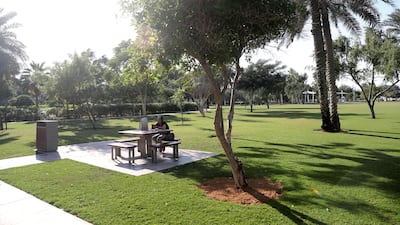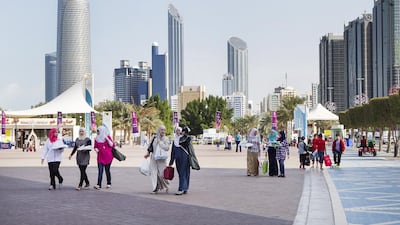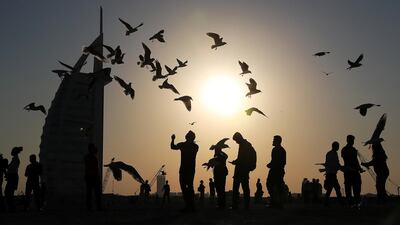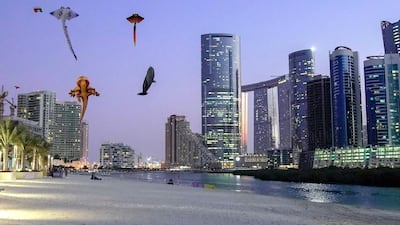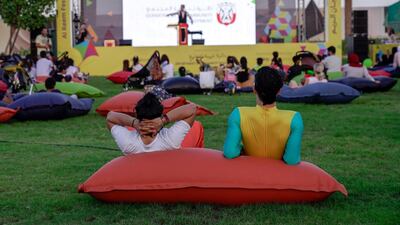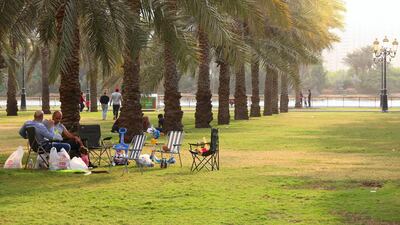UAE residents say existing public green space in the cities where they live makes a major contribution to their personal happiness, but more is needed closer to home and with better facilities.
The findings are part of a study, produced by Masdar in partnership with The National and the World Future Energy Summit, to coincide with Abu Dhabi Sustainability Week which begins on Saturday.
In a survey, 65 per cent of respondents said that existing green public space in their city added to their personal happiness by a large extent.
More than a third of respondents cited mental health benefits as the main role of green public space in a city.
Overall, 87 per cent regularly visit public green spaces, while those who don’t say this is largely because there are not enough of them (28.3 per cent), current facilities are poor (27 per cent) or they are too far away (22 per cent).
More than 500 people, almost all of them living in the UAE, took part in the online poll, with 72 per cent living in Abu Dhabi and 21 per cent in Dubai.
The survey is part of the report, People and spaces: The role of urban green spaces in cultivating innovation, sustainability and health and well-being in Arab cities, which analyses one of the world's major challenges over the next decade – how to ensure life in our cities is a happy, healthy reality as urban populations grow dramatically.
“The importance of public space for both mental and physical well-being is a recurring refrain of this report….[which I hope] provides insight and encouragement to all involved in sustainable development of our towns and cities,” said Masdar chief executive Mohamed Al Ramahi in a foreword to the study.
Around half of the world’s inhabitants currently live in cities, 548 of which have populations of at least one million. By 2030, that number is expected to grow past 700.
“The survey results demonstrate a maturing society that is looking at these kinds of facilities as integral to their lifestyles and quality of life”, said Lukas Sokol, Masdar’s head of city design and sustainable planning.
“They also indicate that, in terms of quality of life, the provision of public green spaces is a route to serving a very high proportion of the population with something they want.”
Respondents were asked to choose their favourite outdoor location in the Emirates, with Umm Al Emarat Park in Abu Dhabi the most popular choice, followed by Abu Dhabi corniche and then ‘the beach’ in third place.
“It is really refreshing news for everybody who doesn’t necessarily have access to the lovely natural amenity which is the beach but it means you can provide quality open spaces that are demanded by the citizens and are actually preferred,” said Mr Sokol.
Covering the widest range of amenities, from parks to town squares to community art installations, public spaces make up 12 per cent of the land area of the average European city, according to the UN. However, the figure for Middle Eastern cities is as low as 2 per cent, with the region’s challenging climate an obvious contributing factor.
Mr Sokol said: “The study uncovers some really interesting opportunities for the public and the private sector. It is affirming and expanding on the importance of public realm and the work that is already being done in the UAE.
“With some of the government initiatives, they are looking at enhancing the public realms and providing not only access to more parks but also more natural areas.”
Abu Dhabi, for example, will spend Dh8 billion on transforming its public places and parks into community spaces for all residents.
The report sheds new light on why public spaces must have their proper place in the urban planning process if the transformation of Arab towns and cities is to achieve lasting benefits for the mind, body and planet.
It sees that the struggle to make future cities better places to live for millions of additional residents, inevitably, includes a major role for new digital technology, and in particular, artificial intelligence.
“Most developments are primarily experienced in the outside. For developers the survey results are a really important message because it now means that public green spaces are an integral part of your development that will raise the value of your properties,” Mr Sokol said.
Outdated design principles do present an obstacle to progress, however, and lessons must be learnt from mistakes of the past, according to the report.

